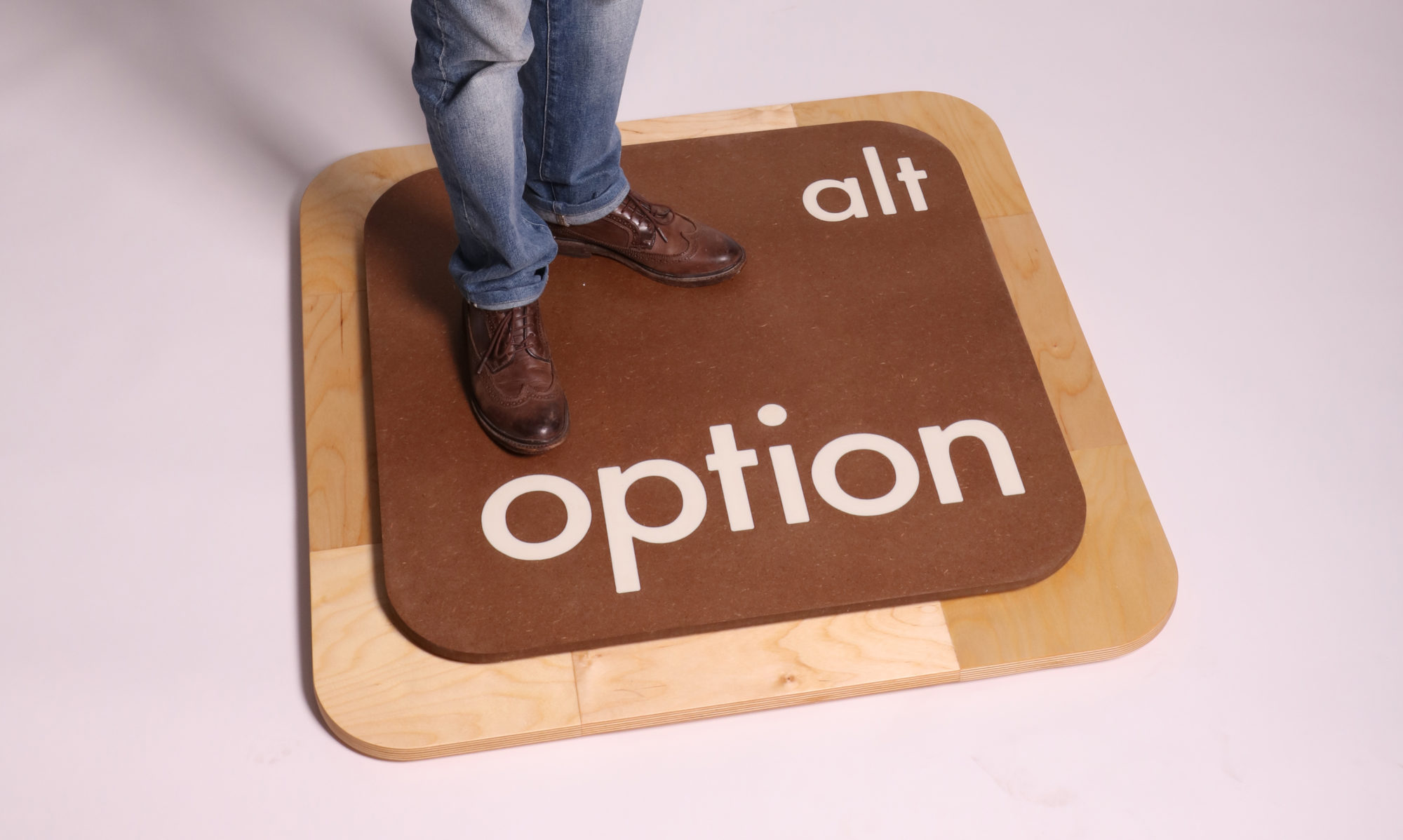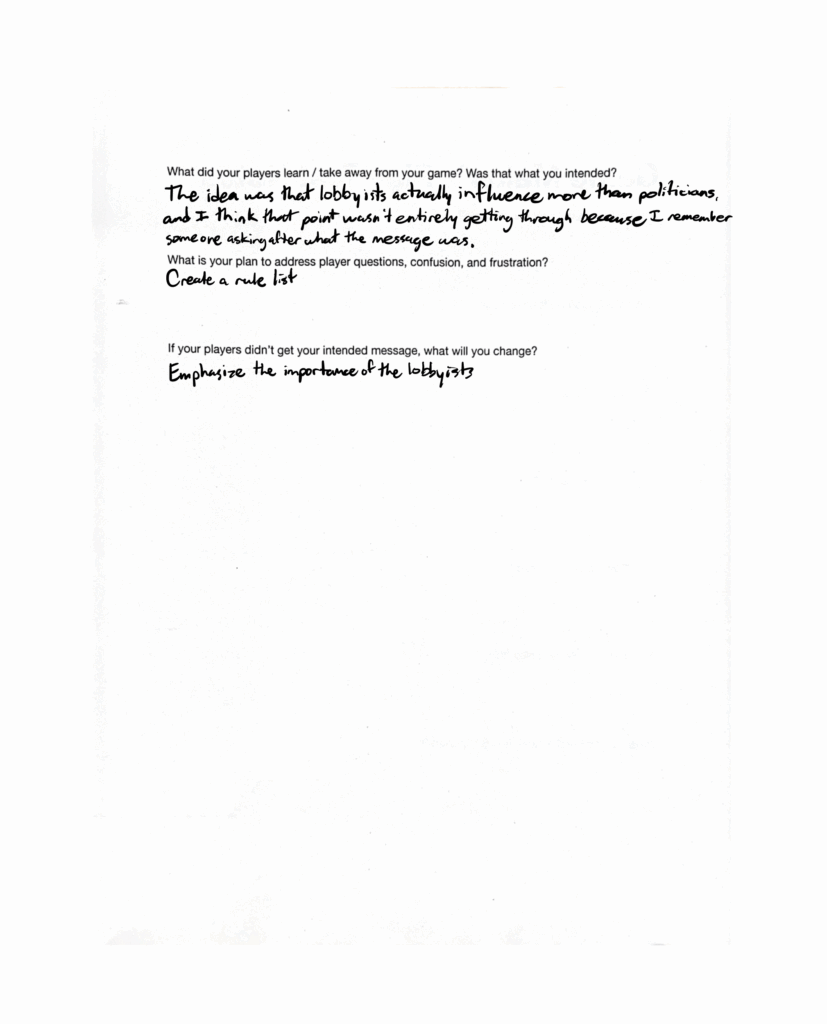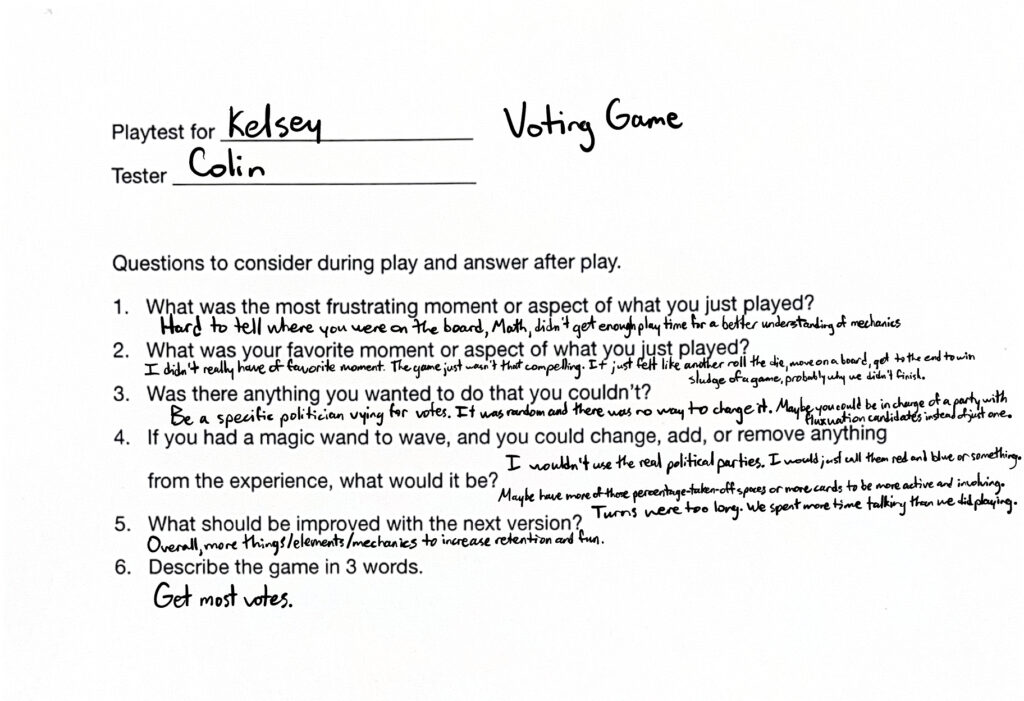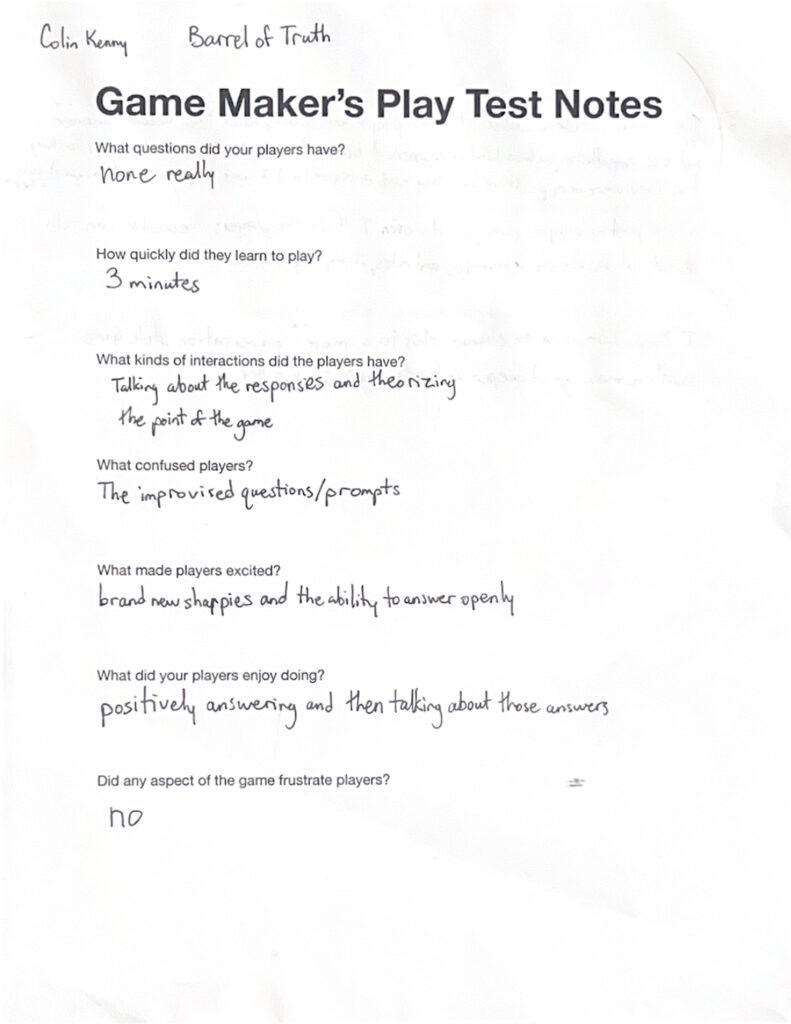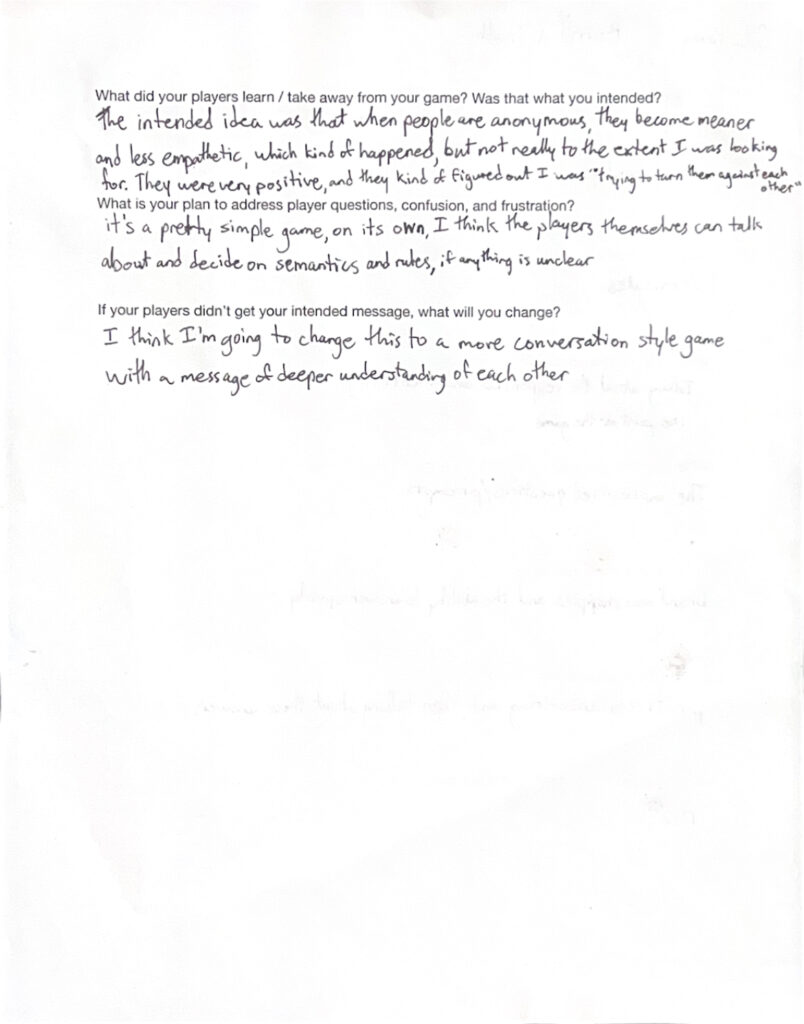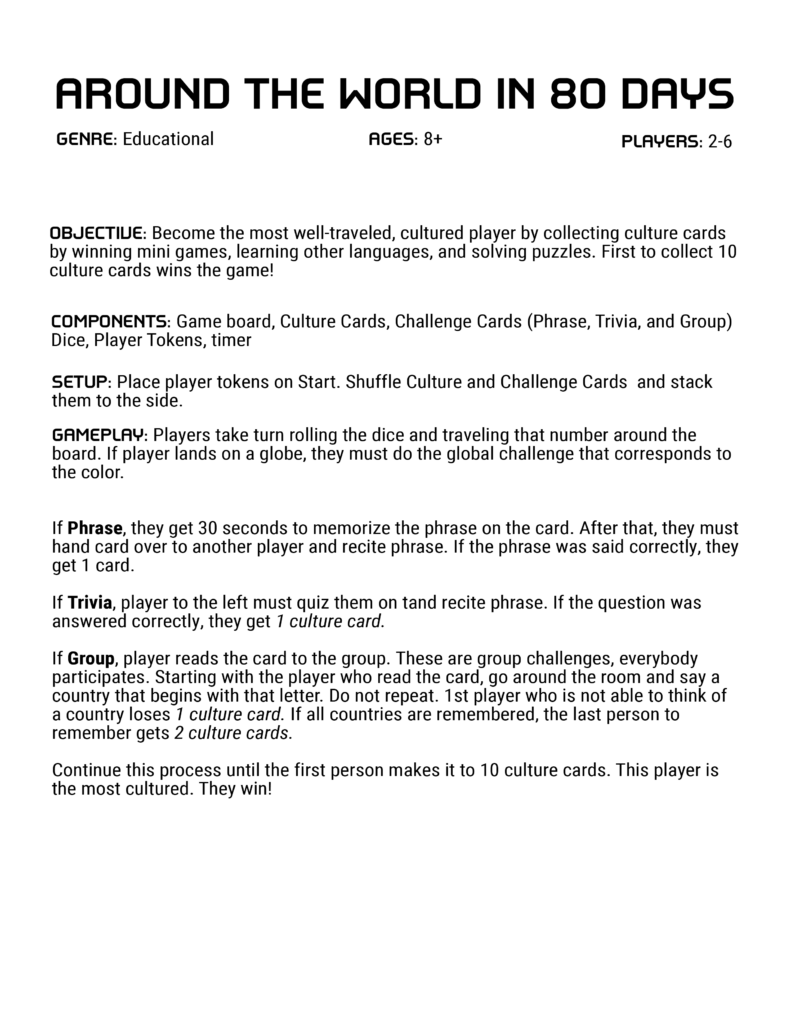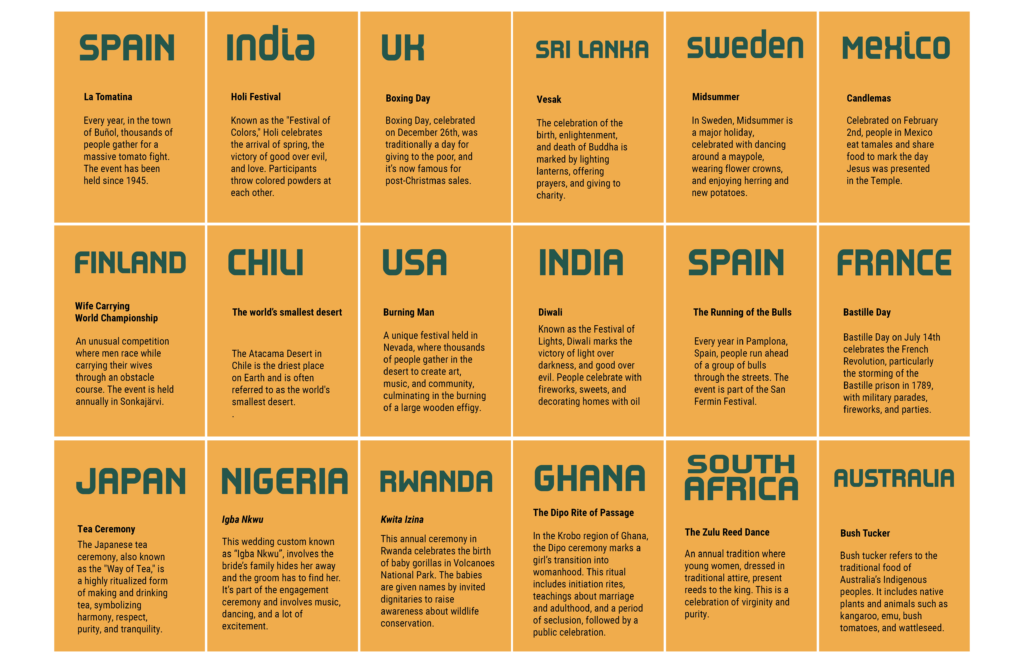Game Tester Notes of Help Our Guy: The Political Card Game – Colin Kenny
Atlas Arcade Final Documentation
Game Review of Kelsey’s Voting Game (I forgot the name.) – Colin Kenny
Game Review of Kelsey’s Butterfly Effect Game – Colin Kenny
Barrel of Truth Version 2 Rules -Colin Kenny
All players are given a pen and piece of paper per round. On their turn, players draw a card and read it aloud to the group, as well as its category, either public or anonymous. If public, all players write their names in the corner of their paper. If anonymous, players should only write their answers. Once everyone is finished, they drop their papers into the barrel, the card drawer closes the lid, shakes it well, then removes the lid and reads all of the responses. Then, players are encouraged to discuss and have meaningful conversations regarding the topic and responses. Play continues clockwise. Play ends when players feel they know each other much better.
Hues and Cues Game Review
I enjoy this game but it really shows how limited my vocabulary is and how slowly I can think on the spot. Evelyn mentioned when she played before all players took turns putting their pieces on the board instead of all at once. I like how we all rushed at once because it adds a more competitive aspect to the game. I think it also makes the game go faster when you have a lot of players.
My frustration with this game is that the card colors do not match the game board colors very well. I think if you are making a hues game with a lot of color variation, you better make sure the colors match correctly. I think they should really fix that because you have to look at the board code color when you are giving cues and people can tell where you are looking if you are not strategic.
I like how you get points for how many people got in the square when you care giving cues. It makes the hinter really want to think of good words because it benefits them when the other players go good.
Also I wished the board laid more flat when playing but thats just me being picky.
Rules for Barrel of Truth (Version 1)- Colin Kenny

Each player is given a Sharpie or any type of pen, but all of them must be identical. Each round, the host (me) hands each player a slip of paper and asks them to respond to a question or prompt pertaining to the other players. It can be in the form of an assumption, and opinion, a secret, etc. No direction is given whether the responses SHOULD be positive or negative. Some rounds will require players to write their own names on their slips along with their answers, other round they must be completely anonymous. After every player has answered, they will put their slip in the barrel, the barrel is closed and mixed, and each answer is read aloud by the host. The players are suggested to share thoughts and feelings of the responses. Once everyone is ready, the next round begins. The game ends whenever the players either hate each other or get bored.
Play Test Notes for Barrel of Truth- Colin Kenny
Review of Sara and Amber’s Game, Cry Me A Pond- Colin Kenny
The Barrel Of Truth Playtest
What was the most frustrating moment or aspect of what you just played?
Not understanding the game/having no rules going in.
What was your favorite moment or aspect of what you just played?
Listening back to all of the players responses.
Was there anything you wanted to do that you couldn’t?
I wanted to know who wrote certain answers.
If you had a magic wand to wave and you could change, add, or remove anything from the experience, what would it be?
Have it so the players take turns generating the prompts to respond to.
What should be improved with the next version?
Have some guided directions/rules
What was the game’s message?
Anonymity breeds negativity
Describe the game in 3 words.
discussion, honesty, negativity
Evelyn [prot.1] Around the World in 80 Days
Week 4 Questions
- what learning games have you played? can you categorize them by the theory of learning types: behaviorism, constructivism, constructivism or social nature? if you played more than one which was the most effective? the most memorable was Mavis Beacon Typing and speed math tests in elementary school. Both of these were behaviorist. Essentially, the goal of both was to make you more effective and fast at a skill.
- is gamification bullshit, what is ian bogost’s argument and do you agree? where have you encountered it outside of class and what was your experience? Bogust believes that marketing has abused the use of gamification in their business strategy. I disagree with him. I think that applying gamification to business strategy motivates workers and sets practical goals and milestones. Outside of class, I have seen gamification in some e-commerce apps – specifically temu and shein. They utilize mini games in apps to trick users to think they can earn and win free items (when in reality they need to share the app or do some outside marketing for them to win the items). They also use check-in bonuses and points systems.
- What is a serious game and why aren’t they chocolate covered broccoli? a serious game is a game are intended for education or professional development. Matthew Farber believes chocolate-covered broccoli games are those that poorly engage users and have bad design. Perhaps they do not have game mechanics that are on par with main stream games.
Week 4 Post
Alana Tush
Crossing the bridge thoughts- I wasn’t in class so I didn’t get to see it played, but I looked up images and it looks similar to some of the other games as have looked up where you have to walk and maneuver through things with the character. It also looks similar to some modern-ish games like stick ninja or something.
What learning games have you played?
Cool math games is still fun and sum dog used to be the shit in elementary school. At the time I didn’t think I was actually learning anything or at least practicing math but it is an effective way to keep kids sharp. While I liked cool math games better, I think sumdog was a better learning game because it wasn’t as broad as cool math games.
What is ian bogost’s argument and do you agree?
His argument is that “gamification is marketing bullshit, invented by consultants as a means to capture the wild, coveted beast that is video games and to domesticate it for use in the grey, hopeless wasteland of big business, where bullshit already reigns anyway.” I agree with him, while I’m not well versed in the game community, all marketing has some twisted/ or un-true element to entice consumers.
What is a serious game and why aren’t they chocolate covered broccoli?
Serious Gaming is used to teach and provide a message. “Games that blur the line between fun and education”…can be called chocolate covered broccoli. “A coating of sweet does not make the learning suddenly fun.”
New ideas for a serious game
1. Match statistics/facts with things in nature to learn about how the environment is being effected by humans
2. Fill out a bingo card of common items that are over consumed and see the amount of over consumption you participate in. For example- owning more than 5 reusable water bottles
3. kids game where they have to practice multiplication to collect items in the grocery store to complete a recipe card. The reward is being able to cook or bake the recipe
Week 3
Alana Tush
Class Discussion thoughts- I didn’t grow up playing many games, and I don’t really do so now, so I was pretty lost when everyone was discussing their thoughts on the games being presented.
Dumb Ways to Die Thoughts- what was played in class seemed to be an updated version of the game, I remember some of the levels, but some were new. I played this game a lot on my I pod touch J. It was fun when I was younger but now it just seems stupid.
Fake it to Make it Thoughts- I thought this game was a good way to show how fake news is spread. It spreads more awareness of how gullible we are than actually having fun playing the game.
Cast Your Vote Thoughts- this game shows the player how to cast a vote and shows how important it is to make an educated decision rather than blindly voting.
Generate a list of five game ideas that revolve around the theme of empathy. Wrinkle: Take one of the five ideas and make it an alternate reality game.
Kindness Bingo– complete acts of kindness to fill a bingo card, encouraging positive behavior.
Feelings Charades– act out emotions, helping players recognize and empathize with different feelings.
Role Reversal- Players switch roles in a scenario, (parent/child, professor/student) to experience challenges from each other’s point of view
From chapter 1:
How does Mary Flanagan’s definition of game differ from chris Crawford’s as well as the definition crafted by Katie Salen and Eric Zimmerman?
Mary Flanagan’s definition- “Games can be thought of more productively as situations with guidelines and procedures.”
Chris Crawford’s definition- Games can evolve, and rules may shift at certain points in a game and can change with the player’s actions.”
Katie Salen and Eric Zimmerman definition- “system in which players engage in an artificial conflict, defined by rules, that results in a quantifiable outcome.”
Mary Flanagan’s definition has less structure than Katie Salem and Eric Zimmermans’ outline of a game.
What is an activist game?
Activist games have emphasis on social issues, education, and intervention. They are games that engage in a social issues through: themes, narratives, roles, settings, goals, and characters.
From chapter 3:
– Go and chess are examples of games that feature “perfect information”, what other games share that feature?
Perfect information- “all the information constituting the system of the game is visible on the game board at all times. Play in an abstract strategy game often unfolds as players move pieces on the board, creating a set of ongoing puzzles for other players to thwart.”
Examples- checkers, scrabble?, tic tac toe
– Why might chance or gambling games hold spiritual or religious importance to ancient cultures?
They saw games as a way to connect with the powers of fate, chance, and the afterlife.
– When was the earliest battle between government/ religious groups and games? what modern games can you think of that have been banned or demonized?
European’s in the Middle Ages were captivated by the game and the church fought to forbid its play. The battle between government or religious groups and games is at least as old as this event, if not much older. When faced with the popularity of style games in Europe, the church decided to use the game to further its religious message.
– What is a fox game, and what would be a modern example?
Fox game- board games featuring unequal opponents, one player is the fox, or aggressor. Other players control or play the prey. The fox attempts to avoid the traps his opponents set all around him.
– What was the purpose or intent of the game: Mansion of Happiness?
Purpose- “Children would take these principles to heart and connect wholesome thoughts to the secular joys of competing for positions, projecting themselves into situations of good and evil, and enjoying the company of their playmates and family.” Reinforcing good morals
– Why do artists from the Fluxus and Surealist movements play games? Why did Surealists believe games might help everyone?
They play games as form of recreation and research.
– Changes in what can signal profound changes in games? How were pinball games reskinned during WW2?
Changes in the economy can signal profound changes in games. “Pinball gained widespread popularity in the United States, United Kingdom, and France, mass- produced as a popular pastime for military men.”
